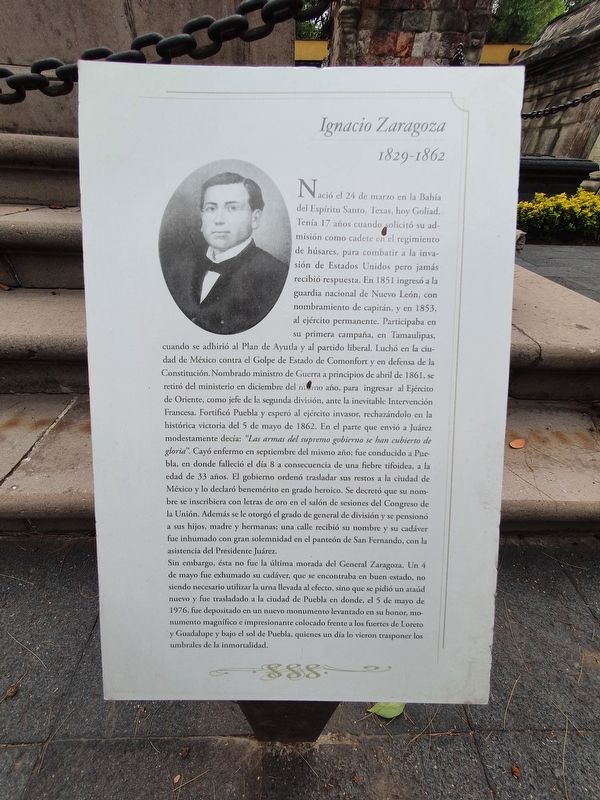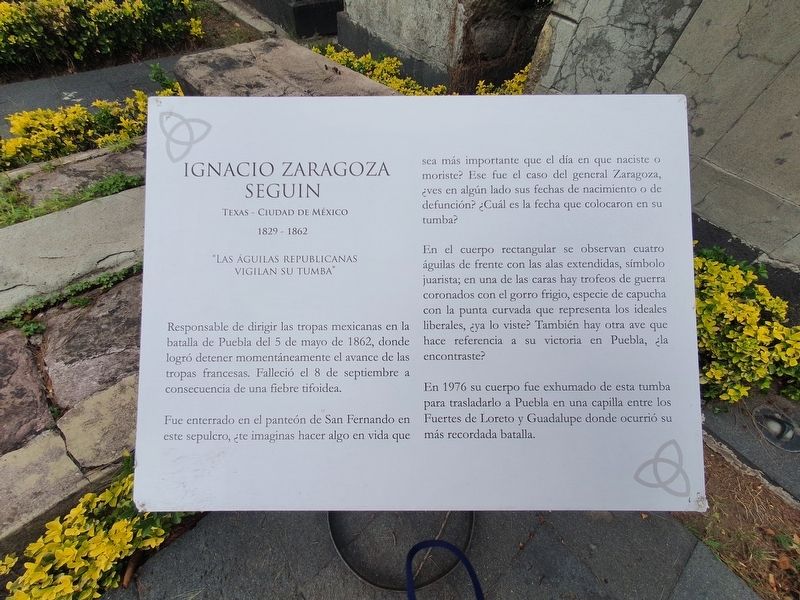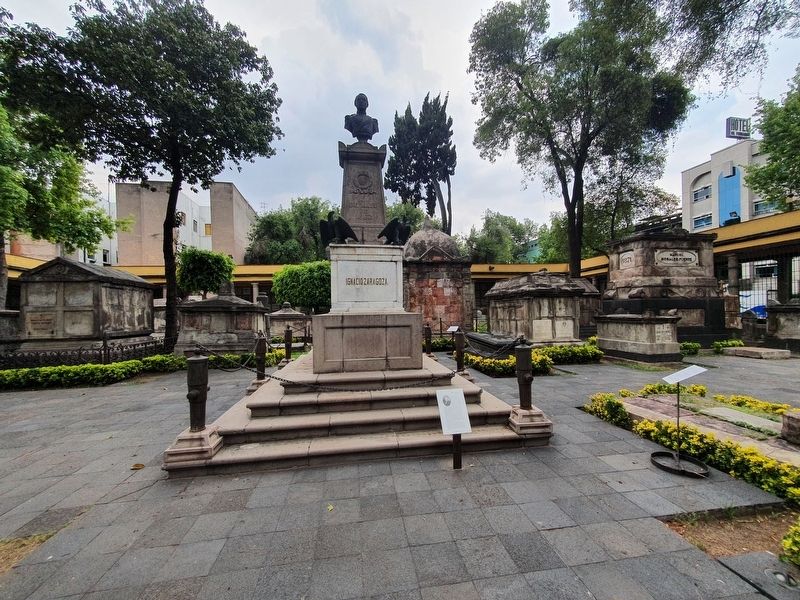Centro Histórico in Ciudad de México, Mexico — The Valley of Mexico (The Central Highlands)
Ignacio Zaragoza
1829-1862
Nació el 24 de marzo en la Bahía del Espíritu Santo, Texas, hoy Goliad. Tenía 17 años cuando solicitó su admisión como cadete en el regimiento de húsares, para combatir a la invasión de Estados Unidos pero jamás recibió respuesta. En 1851 ingresó a la guardia nacional de Nuevo León, con nombramiento de capitán, y en 1853, al ejército permanente. Participaba en su primera campaña, en Tamaulipas, cuando se adhirió al Plan de Ayutla y al partido liberal. Luchó en la ciudad de México contra el Golpe de Estado de Comonfort y en defensa de la Constitución. Nombrado ministro de Guerra a principios de abril de 1861, se retiró del ministerio en diciembre del mismo año, para ingresar al Ejército de Oriente, como jefe de la segunda división, ante la inevitable Intervención Francesa. Fortificó Puebla y esperó al ejército invasor, rechazándolo en la histórica victoria del 5 de mayo de 1862. En el parte que envió a Juárez modestamente decía: "Las armas del supremo gobierno se han cubierto de gloria". Cayó enfermo en septiembre del mismo año; fue conducido a Puebla, en donde falleció el día 8 a consecuencia de una fiebre tifoidea, a la edad de 33 años. El gobierno ordenó trasladar sus restos a la ciudad de México y lo declaró benemérito en grado heroico. Se decretó que su nombre se inscribiera con letras de oro en el salón de sesiones del Congreso de la Unión. Además se le otorgó el grado de general de división y se pensionó a sus hijos, madre y hermanas; una calle recibió su nombre y su cadáver fue inhumado con gran solemnidad en el panteón de San Fernando, con la asistencia del Presidente Juárez.
Sin embargo, ésta no fue la última morada del General Zaragoza. Un 4 de mayo fue exhumado su cadáver, que se encontraba en buen estado, no siendo necesario utilizar la urna llevada al efecto, sino que se pidió un ataúd nuevo y fue trasladado a la ciudad de Puebla en donde, el 5 de mayo de 1976, fue depositado en un nuevo monumento levantado en su honor, monumento magnífico e impresionante colocado frente a los fuertes de Loreto y Guadalupe y bajo el sol de Puebla, quienes un día lo vieron trasponer los umbrales de la inmortalidad.
Ignacio Zaragoza Seguin
Texas – Ciudad de Mexico
1829-1862
"Las aguilas republicanas vigilan su tumba"
Responsable de dirigir las tropas mexicanas en la batalla de Puebla del 5 de mayo de 1862, donde logró detener momentáneamente el avance de las tropas francesas. Falleció el 8 de septiembre a consecuencia de una fiebre tifoidea.
Fue enterrado en el panteón de San Fernando en este sepulcro, ¿te imaginas hacer algo en vida que sea más importante que el día en que naciste moriste? Ese fue el caso del general Zaragoza, ¿ves en algún lado sus fechas de nacimiento o de defunción? ¿Cuál es la fecha que colocaron en su tumba?
En el cuerpo rectangular se observan cuatro águilas de frente con las alas extendidas, símbolo juarista; en una de las caras hay trofeos de guerra coronados con el gorro frigio, especie de capucha con la punta curvada que representa los ideales liberales, ¿ya lo viste? También hay otra ave que hace referencia a su victoria en Puebla, ¿la encontraste?
En 1976 su cuerpo fue exhumado de esta tumba para trasladarlo a Puebla en una capilla entre los Fuertes de Loreto y Guadalupe donde ocurrió su más recordada batalla.
Ignacio Zaragoza
1829-1862
Born March 24 in Bahia del Espiritu Santo, Texas, now Goliad. He was 17 years old when he applied for admission as a cadet to the regiment of Hussars, to fight the invasion of the United States, but never received a reply. In 1851 he joined the national guard of Nuevo León, with an appointment of captain, and in 1853, to the standing army. He participated in his first campaign, in Tamaulipas, when he adhered to the Plan of Ayutla and the Liberal party. He fought in Mexico City against the Coup d'état of Comonfort and in defense of the Constitution. Appointed Minister of War in early April 1861, he retired from the Ministry in December of the same year, to enter the Army of the East, as head of the Second Division, before the inevitable French Intervention. He fortified Puebla and waited for the invading army, repulsing it in the historic victory of May 5, 1862. In the letter he sent to Juárez he modestly said: "The weapons of the supreme government have been covered with glory." He fell ill in September of the same year; He was taken to Puebla, where he died on the 8th as a result of typhoid fever, at the age of 33 years. The government ordered his remains to be transferred to Mexico City and declared him heroically meritorious. It was decreed that his name be inscribed in gold letters in the Hall of Sessions of the Congress of the Union. In addition, he was awarded the rank of major general and his children, mother and sisters were given pensions; a street received his name and his corpse was buried with great solemnity in the pantheon of San Fernando, with the assistance of President Juárez.
However, this was not the last resting place of General Zaragoza. On May 4 his body was exhumed, which was in good condition, not being necessary to use the urn carried for that purpose, but a new coffin was requested and was transferred to the city of Puebla where, on May 5, 1976, it was deposited in a new monument erected in his honor, a magnificent and impressive monument placed in front of the forts of Loreto and Guadalupe and under the sun of Puebla, who one day saw him pass over the thresholds of immortality.
Ignacio Zaragoza Seguin
Texas – Mexico City
1829-1862
"Republican eagles guard his grave"
He was responsible for leading the Mexican troops in the Battle of Puebla on May 5, 1862, where he managed to momentarily stop the advance of the French troops. He died on 8 September as a result of typhoid fever.
He was buried in the pantheon of San Fernando in this tomb, can you imagine doing something in life that is more important than the day you were born you died? That was the case of General Zaragoza, do you see anywhere his dates of birth or death? What is the date they placed on his tomb?
In the rectangular body of the monument there are four eagles in front with outstretched wings, a symbol of Juarez; On one of the faces there are war trophies crowned with the Phrygian cap, a kind of hood with a curved tip that represents the Liberal ideals, have you seen it yet? There is also another bird that refers to his victory in Puebla, did you find it?
In 1976 his body was exhumed from this tomb to move it to Puebla in a chapel between the Forts of Loreto and Guadalupe, site of his most-remembered battle.
Topics. This historical marker is listed in these topic lists: Patriots & Patriotism • Wars, Non-US. A significant historical date for this entry is March 24, 1851.
Location. 19° 26.344′ N, 99° 8.88′ W. Marker is in Ciudad de México. It is in Centro Histórico. Marker can be reached from Calle San Fernando, on the right when traveling west. The marker is on the grounds of the Panteón San Fernando. Touch for map. Marker is at or near this postal address: C San Fernando 17, Ciudad de México 06300, Mexico. Touch for directions.
Other nearby markers. At least 8 other markers are within walking distance of this marker. Manuel Ruiz (here, next to this marker); Ignacio Comonfort (here, next to this marker); Tomás Mejía (here, next to this marker); José María Lafragua (a few steps from this marker); Juan de la Granja (a few steps from this marker); Juan C. Doria (a few steps from this marker); Margarita Maza de Juárez (a few steps from this marker); Lino José Alcorta (a few steps from this marker). Touch for a list and map of all markers in Ciudad de México.
Credits. This page was last revised on February 28, 2023. It was originally submitted on February 28, 2023, by J. Makali Bruton of Accra, Ghana. This page has been viewed 86 times since then and 25 times this year. Photos: 1, 2, 3. submitted on February 28, 2023, by J. Makali Bruton of Accra, Ghana.


